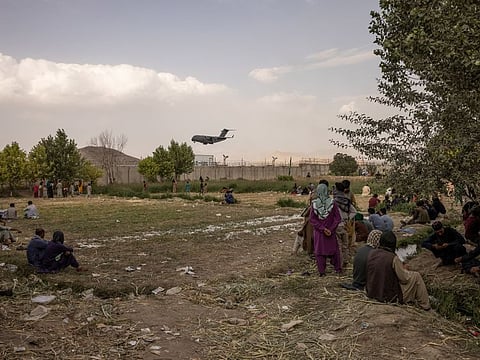US longest war in Afghanistan is over, but difficult questions linger
America underestimated Taliban and botched a supposedly long-planned exit

The last American soldier, Major General Chris Donahue, commander of the 82nd Airborne Division, left Afghanistan a minute before Monday’s midnight, ending his country’s longest war that began 20 years ago, following the September 11 attacks.
The United States rushed the final chapter of its two-decade occupation of Afghanistan in a chaotic, fraught and even bloody departure, leaving the war- ravaged country in the hands of the enemy, Taliban.
Years from now, two images will remain edged in the history books that define what most American analysts describe as ‘humiliating defeat in Afghanistan’.
The image of Major General Donahue, taken by a Pentagon photographer with night- vision lenses, as he boarded the final flight, a military C-17 aircraft, out of Kabul and the image of Taliban fighters firing in the air to celebrate taking full control of the Hamid Karzai International Airport will be the seminal images of this war.
Hasty and humiliating retreat
America for years has sought an honourable way out of its ‘forgotten’ and longest running war in Afghanistan. But few expected its exit would be hasty and humiliating, leaving the Taliban to declare victory over “a great power”, as noted by Taliban spokesman Zabihullah Mujahid, who described Monday’s final retreat by the US forces as “historical day and a historical moment.”
The Taliban spokesman may have overshot here but the reality is that it was unexpectedly a uniquely bizarre end to a war that took the lives of nearly 2,500 American soldiers and 240,000 Afghans, and cost around $2 trillion. It was a brazen failure overseen by one man who should expect a harsh unforgiving judgment from history as well as from the American public opinion: President Joe Biden.
His defenders may claim that the president, who campaigned in the 2020 election on his strength in foreign affairs, inherited a 20-year losing war from his three predecessors and his decision to leave was basically to cut US losses and save lives.
But the fact is that his administration failed — in the end — to even organise a pullout that was supposedly years in planning. The administration failed to understand the military situation in a country it had occupied for 20 years, underestimated the ability and swiftness of Taliban’s takeover of major cities and overestimated the capabilities of the Afghan government and army.
In his statement late Monday, President Biden said his decision to end the US presence in Afghanistan was based on “unanimous recommendation of the Joint Chiefs and of all of our commanders on the ground to end our airlift mission as planned.”
He said the US had achieved its objectives in Afghanistan “long ago” — mainly ousting the Taliban and preventing Al Qaeda to use Afghanistan as a base for further terror attacks.
Biden will of course face many questions in the coming days and years, from the American public and disappointed allies. They need to know why he botched a supposedly long planned exit, leaving Afghanistan in the hands of a stronger, empowered Taliban.
Sign up for the Daily Briefing
Get the latest news and updates straight to your inbox








